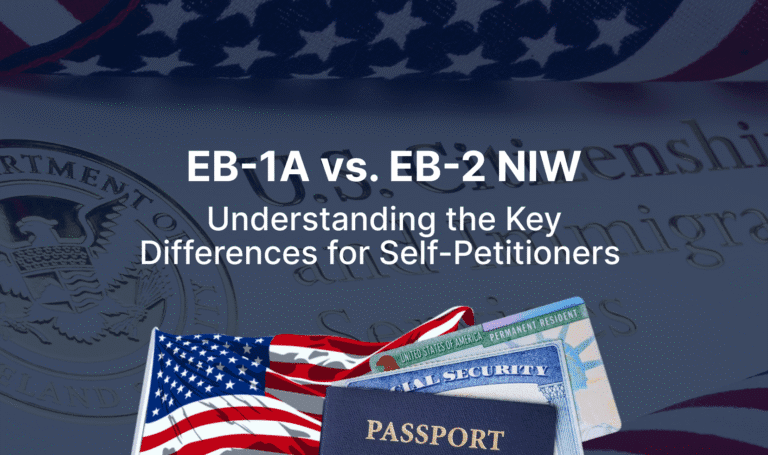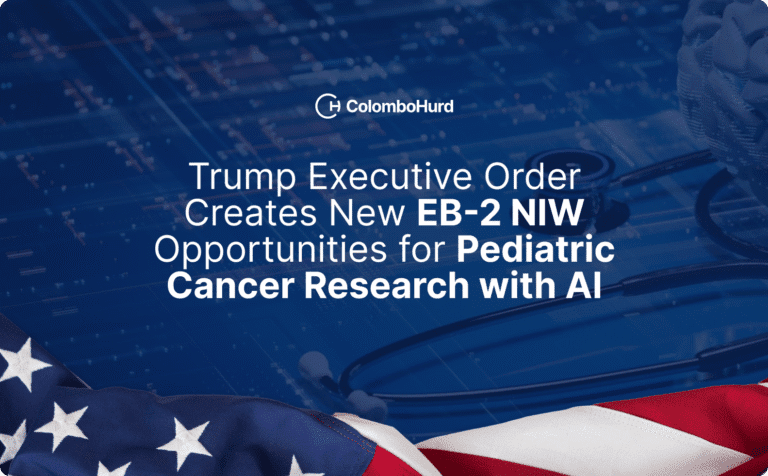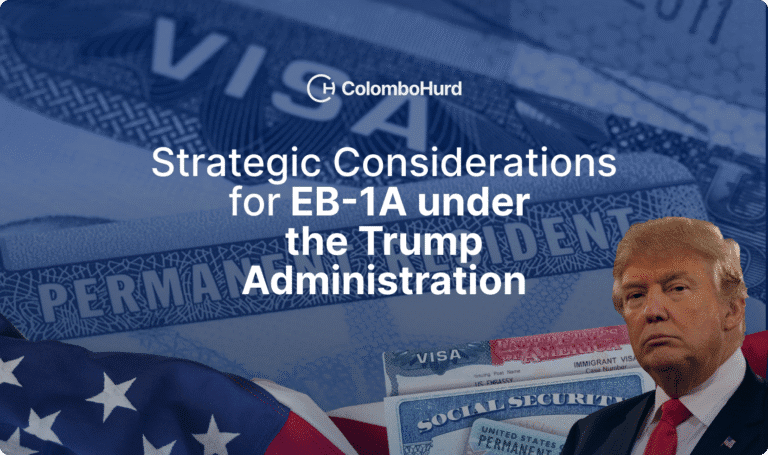For professionals exploring self-petitioned options for U.S. permanent residence, EB-1A and EB-2 NIW stand out for their flexibility and independence. Both allow qualified individuals to pursue a green card without employer sponsorship, making them ideal for professionals who want to advance their careers on their own terms.
This overview highlights the core distinctions between EB-1A and EB-2 NIW, including differences in eligibility standards, evidentiary expectations, and strategic considerations. Understanding these nuances can help qualified professionals select the approach that best fits their achievements, timing, and long-term objectives.
Overview of EB-1A and EB-2 NIW
What is EB-1A?
The EB-1A category is reserved for individuals who have demonstrated extraordinary ability in science, arts, education, business, or athletics. To qualify, petitioners must show sustained national or international recognition for their achievements, seek to enter the U.S. to continue working in their field of expertise in the United States, and demonstrate that their continued work will benefit the nation.
This path is highly selective, designed for professionals operating at the very top of their fields. However, through a strategic selection and presentation of evidence, the EB-1A is a powerful option for individuals whose achievements have made a measurable impact in their industries.
For a comprehensive overview of EB-1A eligibility, the process, and petition strategies, see the Complete EB-1A Guide.
Recent Policy Developments & Evolving Standards for Extraordinary Ability
In my practice, I monitor USCIS policy updates closely, especially those affecting how “extraordinary ability” is interpreted under EB-1A. Over the past few years, the adjudication standards have become more flexible, allowing petitioners to present a broader range of evidence to demonstrate sustained acclaim in their field.
The October 2, 2024, updates to the USCIS Policy Manual reflect this evolution. The agency now recognizes additional forms of achievement, such as team-based awards, past memberships in selective organizations, and a wider variety of published material. These changes signal a more inclusive approach to evaluating extraordinary ability and create opportunities for petitioners to showcase their accomplishments more effectively.
Key updates include:
- Team Awards: USCIS may consider receipt of team-based awards under the criterion for “lesser nationally or internationally recognized prizes or awards for excellence in the field of endeavor.”
- Memberships: The agency will consider past memberships under the criterion for associations in the field that require outstanding achievement of their members.
- Published Material: USCIS also removed language suggesting that published material about the beneficiary in professional or major trade publications or other major media must demonstrate the value of the person’s work and contributions.
These adjustments reflect a more flexible and inclusive approach to assessing extraordinary ability, enabling petitioners to highlight a broader range of achievements that demonstrate excellence and impact within their field.
What is EB-2 NIW?
The EB-2 NIW (National Interest Waiver) is intended for professionals who hold advanced degrees or possess exceptional ability in their field. To qualify, petitioners must show that their work has substantial merit and national importance, that they are well positioned to advance their field, and that, on balance, it would be beneficial to the United States to waive the usual requirements of a job offer and labor certification.
In my experience, the EB-2 NIW provides an excellent opportunity for professionals whose work directly contributes to U.S. national priorities, whether in research, business, public policy, or emerging industries. With the right evidence and a well-defined proposed endeavor, many petitioners outside traditional STEM fields can succeed under this category.
Our EB-2 NIW Complete Guide gives an in-depth overview of everything professionals need to know to self-petition under the EB-2 NIW category.
Updated USCIS Guidance in 2025
The January 2025 Policy Manual update refined how officers assess national importance. Officers look more closely at whether a petitioner’s work aligns with U.S. national priorities and benefits the nation as a whole, not just a single employer or local community.
This update also expanded the types of evidence petitioners can submit, such as letters of support from government agencies or recognized industry leaders that directly connect the work to national needs.
These refinements have also created new opportunities for a wider range of professionals. Petitioners no longer need to be in STEM fields or have extensive publications to qualify. Business, finance, and other professionals can also succeed under the NIW if they clearly demonstrate how their work advances U.S. interests.
It’s also important to understand that EB-2 NIW and EB-1A are not mutually exclusive. Many petitioners believe they must choose between the two, but in practice, it can be advantageous for certain petitioners to pursue both. Filing under both categories can potentially maximize approval chances and minimize wait times for permanent residency, especially given visa backlogs and uncertain processing times.
Side-by-Side Comparison
| Criterion | EB-1A (Extraordinary Ability) | EB-2 NIW (National Interest Waiver) |
| Eligibility | Extraordinary Ability in sciences, arts, education, business, or athletics | Advanced Degree or Exceptional Ability + Dhanasar criteria |
| Labor Certification | Not required | Waived if in U.S. national interest |
| Job Offer | Not required | Waived if in U.S. national interest |
| Evidence | Evidence of Prizes/Awards, Memberships, Published Material about the petitioner and their work, Participation as judge of the work of others, Scholarly articles authored by petitioner, Leading or Critical Role, Salary, Commercial success in performing arts, Work displayed at artistic exhibitions or showcases, Original Contributions of Major Significance | Substantial merit and national importance of proposed endeavor, petitioner’s education, skills, knowledge, and record of success, model or plan for future activities, interest from relevant entities, progress toward achieving the endeavor |
| Processing Time | Premium processing available, often faster | Premium processing available, may face longer waits |
| Visa Backlogs | Usually shorter; dates often current | Often longer, especially for India and China |
| Best Fit | Petitioners with international recognition and sustained acclaim, professionals at the top of their field. | Petitioners whose work benefits U.S. industries or national priorities |
Key Similarities
Both EB-1A and EB-2 NIW allow applicants to self-petition, avoiding the need for employer sponsorship and making them attractive options for professionals seeking an immigration pathway not tied to an employer.
Key Differences
Eligibility Requirements
- EB-1A petitioners must prove extraordinary ability, either through a one-time major award or by meeting at least three of ten USCIS criteria.
- EB-2 NIW petitioners must first qualify under either the advanced degree or exceptional ability classification and then satisfy three prongs under Dhanasar:
- That the proposed endeavor has substantial merit and national importance,
- That the petitioner is well positioned to advance the proposed endeavor; and
- That, on balance, it would be beneficial to the United States to waive the requirements of a job offer and thus of a labor certification.
Evidence Required
- EB-1A petitions focus on extraordinary achievements such as international awards, influential publications, or media coverage.
- EB-2 NIW petitions emphasize a defined proposed endeavor, evidence of the substantial merit and national importance of the endeavor, and evidence of the petitioner’s past work, expertise, and future plans demonstrating their being well-positioned to advance the endeavor, including recommendation letters, letters of interest, a developed model or plan, certifications, work experience letters, patents, funding, etc.
When it comes to evidence selection, strategic considerations can impact the strength of a petition. For example, petitioners may wish to focus on quality over quantity of evidence. Submitting a few strong letters of recommendation can be far more effective than presenting many more letters with less impactful language. Additionally, overly focusing on the prestige of recommenders’ profiles, when they far exceed that of the petitioner’s, can backfire, as USCIS may improperly and unfairly compare the petitioner’s profile to their recommenders, which can dilute rather than strengthen the overall case.
This is especially true for EB-1A petitions. It is important to keep in mind that EB-1A is not a discretionary category, and the strength and credibility of the evidence submitted for each criterion are critical to success. Accordingly, petitioners should focus on carefully selecting evidence that plainly meet the evidentiary criteria.
Recent USCIS guidance has also broadened what qualifies as persuasive evidence. The agency now recognizes team awards and shared achievements under EB-1A, giving petitioners more flexibility in demonstrating extraordinary ability. For NIW, this expanded interpretation has opened doors for professionals well beyond academia. We’re seeing consistent approvals for individuals in fields like business, finance, and emerging industries, particularly when they clearly link their work to U.S. national priorities.
National Interest Component
- The national interest test is central to EB-2 NIW. Petitioners must show their work benefits the United States beyond a single employer.
- EB-1A petitions do not require this; instead, the focus is on extraordinary ability and recognition.
Labor Certification and Job Offer
- EB-1A does not require a labor certification or a job offer.
- EB-2 normally does, but in EB-2 NIW cases, the requirement is waived if the petitioner demonstrates that the waiver is in the national interest.
Processing Time, Backlogs, and Visa Availability
Processing times vary depending on the category and the petitioner’s country of chargeability.
- EB-1A petitions may benefit from shorter backlogs because priority dates are often current. Petitioners can also request premium processing, which allows USCIS to decide the petition within 15 calendar days.
- EB-2 NIW petitions are also eligible for premium processing. However, wait times may be longer if the petitioner is from a country with high demand, such as India or China. Visa backlogs in the EB-2 category can delay final green card approval, even after petition approval.
Understanding the Visa Bulletin and priority dates is essential. Petitioners should track monthly updates to see when their green card process can move forward.
As of the October 2025 Visa Bulletin, there has been some meaningful, though still limited, movement in employment-based categories. EB-1 for China has advanced to December 22, 2022, while India remains at February 15, 2022. For EB-2 NIW, India stands at April 1, 2013, and China at April 1, 2021, with all other countries holding at December 1, 2023. These shifts can significantly influence filing strategy, particularly for applicants from India and China, where visa backlogs remain substantial.
What is Chargeability?
Chargeability refers to the country assigned for visa quotas, usually the country of birth. Petitioners from high-demand countries may wait longer, while others move faster. Cross-chargeability may be possible using a spouse’s country of birth.
Advantages and Disadvantages for Self-Petitioners
- EB-1A may offer a faster pathway to permanent residency compared to EB-2 NIW, but requires proof of Extraordinary Ability.
- EB-2 NIW has a more flexible standard, making it accessible to a wider range of professionals, but may involve longer processing times and require proof of national importance.
EB-1A vs EB-2 NIW: Opportunities for Professionals in Every Field
While neither path is exclusive to specific professions, understanding how each category aligns with different profiles helps petitioners identify the route that best reflects their career and contributions.
- Researchers and academics may qualify under both, depending on the strength of their publications, citations, and recognition.
- Entrepreneurs often succeed with EB-2 NIW if their work supports U.S. economic growth or innovation, while those with global recognition may pursue EB-1A.
- Artists and performers may have a pathway under EB-1A, which carves out specific evidentiary criteria for these professionals.
Application Process Steps
Both EB-1A and EB-2 NIW begin with Form I-140, the Immigrant Petition for Alien Worker. Premium processing is available for faster petition review but does not affect visa backlogs.
Once approved, petitioners in the United States may file Form I-485 to adjust status, while those abroad proceed with consular processing.
Cost Considerations
Government filing fees include the I-140 petition fee and, if applicable, the I-485 adjustment of status fee or consular processing fee. Biometrics fees may also apply.
Premium processing is optional but adds a significant cost in exchange for faster petition review. In addition, petitioners should budget for legal representation, translations, and document preparation. The total cost varies depending on individual circumstances and whether family members are included.
Recent Trends and Policy Updates
In recent years, USCIS has clarified standards for both categories. EB-1A guidance now places stronger emphasis on proving “sustained acclaim” while broadening the types of evidence that can be considered under various criteria. For EB-2 NIW, officers pay closer attention to how an endeavor benefits the United States broadly, not just a single employer or community.
Policy updates and case law continue to shape these categories. Petitioners should stay informed through the USCIS Policy Manual and official announcements to understand current adjudication trends.
For EB-1A petitions, recent policy changes have subtly shifted how officers evaluate both evidence and timing. Over the past year, USCIS guidance has broadened what qualifies as acceptable evidence, making it somewhat easier for petitioners to meet at least three of the regulatory criteria. However, fewer Requests for Evidence (RFEs) do not necessarily indicate that the process has become easier. In many cases, they reflect slower adjudication, rather than more lenient decision-making. Non-premium cases, in particular, are experiencing longer wait times, a factor that petitioners should account for when planning their filing strategy.
I often encourage professionals not to delay filing. Eligibility standards remain stable, and submitting early can help mitigate the impact of unpredictable Visa Bulletin retrogressions. Timely preparation and strategic filing can make a significant difference in maintaining momentum through the green card process.
Conclusion
Both EB-1A and EB-2 NIW offer valuable self-petition options for highly skilled professionals seeking permanent residence in the United States. The EB-1A rewards individuals with extraordinary recognition and sustained acclaim, while the EB-2 NIW focuses on work that holds national importance. Because neither category requires employer sponsorship, both are strong options for professionals who want to pursue their immigration goals independently.
In my experience, the EB-2 NIW remains a highly viable path across a wide range of fields. Strong approvals continue for petitioners who can show that their work supports U.S. national interests, regardless of whether they come from academic, business, or professional backgrounds.
At the same time, the EB-1A can be one of the fastest routes to permanent residency. However, success depends on the quality and clarity of the evidence submitted. Each document should directly support the criteria being claimed and demonstrate that the petitioner is at or near the top of their field.
At Colombo & Hurd, we help professionals determine which path best fits their profile, achievements, and goals. We offer a free EB-1A or EB-2 NIW evaluation to help you understand your options and develop a strategy for success.




